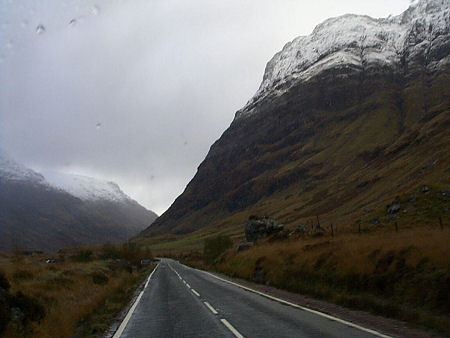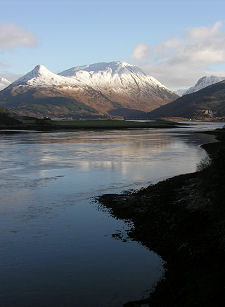 Glen Coe |
Captain Robert Campbell, the 5th Laird of Glen Lyon, lived from 1630 to 2 August 1696. He was a minor member of the Scottish nobility, being a cousin of John Campbell, the 1st Earl of Breadalbane, but is chiefly remembered as the officer commanding the government troops that massacred the MacDonalds of Glencoe on 13 February 1692. The wider picture in Scotland at the time is set out in our Historical Timeline.
As the 5th Laird of Glen Lyon, Robert Campbell inherited Meggernie Castle from his father, and spent freely on converting and extending a traditional castle into a grand mansion. Campbell's expenditure on his castle was only one aspect of a lifestyle that might have been calculated to ruin him. He also gambled and drank excessively and invested in a range of speculative and unsuccessful ventures.
He initially tried to avoid bankruptcy by borrowing heavily from family, friends and even his tenants. He then sold all the timber in the parts of the Caledonian Forest clothing much of Glen Lyon at the time. After being cut down this was floated down the River Lyon, in places blocking the river and causing widespread flooding. Even this was not enough to clear Campbell's debts, so he sold his estate to the Earl of Tullibardine in 1684, moving from the grandeur of Meggernie Castle to the much more modest house owned by his wife at Chesthill, near Fortingall. In 1689 even Chesthill was lost when Jacobite MacIains of Glencoe, relatives of the MacDonalds ofGlencoe, sacked Glen Lyon after the Battle of Dunkeld.
In a final effort to support his family of a wife, three sons, and four daughters, the 59-year old Robert Campbell became an officer in the Earl of Argyll's Regiment of Foot, a regular line regiment of the British Army based at Inverlochy (Fort William) under the command of Colonel John Hill, an English officer who had fought with Cromwell during the English Civil War. Campbell was appointed to the rank of Captain with a salary of 8 shillings a day.
In August 1691 King William III/II offered to pardon all the Highland clans who had taken up arms against him in the 1689 Jacobite uprising. These included the Glencoe MacDonalds. The pardon was conditional on their taking an oath of allegiance to him by 1 January 1692.
A number of clans failed to take the oath, and the Secretary of State for Scotland, Sir John Dalrymple, 1st Earl of Stair, decided to demonstrate his firm grip on the country by punishing one of them. Although some clans had made no effort at all to take it, the Glen Coe MacDonalds, who had tried to take the oath but failed to do so on time, were selected to set this example because they were unpopular, they had no stronghold, and they lived in a valley whose exits could easily be blocked.
Captain Robert Campbell had no reason to like the MacDonalds. The Campbells and the MacDonald's had shared centuries of enmity and it had been the latter's close associates who had destroyed his last holdings in Glen Lyon. And as an elderly, drunk, bankrupt who was heavily dependant on his army salary, he was unlikely to question his orders. He must therefore have seemed the ideal man to command the troops billeted with the MacDonalds in order to massacre them.
And, deliberately or not, by placing a Campbell in charge of the 130 troops (who also included 11 more Campbells) who committed the atrocity, Colonel Hill helped generate the enduring myth that the Massacre of Glencoe was simply another episode in generations of clan feuding.
Although the outcry following the massacre led to the resignation of the Secretary of State for Scotland, Sir John Dalrymple, it had no effect on the careers of any of the army officers involved. Captain Robert Campbell later accompanied the Earl of Argyll's Regiment of Foot to fight in Flanders, where it was part of the army defeated by the French at the Battle of Diksmuide in 1696. Later in the same year Campbell died, drunk and in poverty, in a gutter in Bruges.

